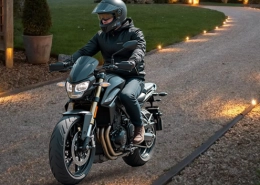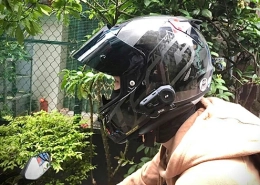Model Selection, Camping Equipment and Practical Tips
Summer is here, and it is a good time for motorcycle camping. Whether it is a mountain road or a forest camping site, free motorcycle camping can release speed and passion, and it is a great opportunity to get close to nature and experience an outdoor lifestyle. However, a summer motorcycle camping trip is full of adventure, freedom and exciting road experience, which requires careful planning and preparation. From motorcycle helmet Bluetooth intercoms to ensure communication and entertainment, to camping equipment, cooking skills and weather response, every detail determines the pleasure of the journey, to ensure that the journey is both pleasant and safe.
Bring your motorcycle and welcome the perfect combination of nature, speed and freedom.
1. Choose the Right Motorcycle Type
The choice of a camping motorcycle determines the comfort and safety of the journey
ADV (Adventure Vehicle)
If you plan to travel long distances through plateaus, mountains, gravel roads or dirt roads, ADV (Adventure Vehicle) is undoubtedly the most suitable choice. The original intention of the ADV model is to cope with complex terrain. Its large front wheel, extended shock absorption stroke, and high ground clearance can easily cope with complex terrain such as mountain gravel, potholes and mud, shallow streams, etc. In addition, ADV is usually equipped with a wide and comfortable seat cushion, thickened hand guards, a raised windshield, a front protection frame and other configurations, which can reduce fatigue even if driving continuously for hundreds of kilometers, and bring higher safety guarantees.
Lightweight Rally Motorcycle or Retro Street Motorcycle
-
- Lightweight rally or retro street cars are more suitable for short-distance riding or camping around the city. The overall body of this type of motorcycle is light and flexible, and the control is simple, which is suitable for female riders or novice riders.
- The rally car’s light frame makes it easy to travel in the city and on gravel roads in the suburbs.
The retro street car combines the retro appearance with the comfort of urban riding, which is suitable for landscape photography and lightweight camping scenes.
All-terrain Tires
Motorcycle camping needs to consider the ability to carry additional equipment. Side boxes, tail boxes, roof bags, etc. must be firmly installed. Choosing a model with a standard tail rack and side rack interface is recommended to ensure that the bags are firmly installed to avoid loosening and falling during driving. All-terrain tires are also necessary equipment. Good grip can maintain stable control on muddy, gravel, and gravel roads, especially in mountainous areas, forests, beaches and other variable road conditions. Matching a model with a ground clearance of at least 150mm is recommended to avoid bottoming out and damaging the vehicle chassis.
Fuel Tank Capacity
The fuel tank capacity determines the cruising range. The road conditions of long-distance crossing in the wild are complicated and there are few supply points. It is recommended to choose a model with a fuel tank capacity of more than 15 liters and prepare a soft spare oil bag to avoid being forced to stay in the wilderness due to insufficient fuel.
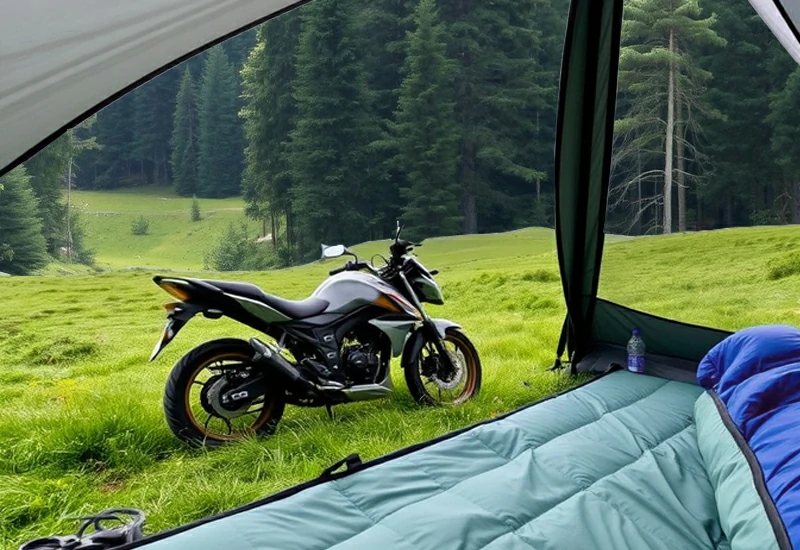
2. Bluetooth Intercoms on Helmets Ensure Communication During Riding
Team communication is crucial during the ride. motorcycle bluetooth helmet intercom can maintain clear and real-time calls during riding, ensuring that team members are aware of route changes, emergencies or rest plans at any time. For areas without mobile phone signal coverage such as mountainous areas and forests, this equipment greatly improves driving safety and riding efficiency.
For motorcycle camping, real-time communication between teams during the ride is crucial. Traditional gestures and parking communications are unsafe and inefficient on complex and changeable mountain roads, forests or highways, and helmet bluetooth headsets just make up for this shortcoming. Whether it is to remind teammates of sharp turns ahead, falling rocks, or suddenly need to change routes or adjust itineraries, just one-click intercom can quickly notify all members to avoid danger.
More importantly, in many signal blind spots such as mountainous areas, forests or plateaus, mobile phones have long lost their function. At this time, Bluetooth intercom becomes the only reliable way to keep in touch with the team. High-quality Bluetooth helmets support automatic grouping, disconnection and reconnection, and priority calls between the front and rear vehicles. Even if the team temporarily distances themselves, communication can be maintained without interruption to ensure smooth information flow. It is especially suitable for long-distance crossings, Sichuan-Tibet Line, and snowy forests.
The SCS S8X Bluetooth motorcycle communication system is equipped with a noise reduction microphone and CVC digital noise reduction technology, which can keep the intercom content clear and avoid wind noise interference even at high speeds or in strong winds. This function not only improves driving safety, but also makes teamwork smoother, adding more security and fun to the entire journey.
3. Reasonable Planning of Camping Equipment
Motorcycle space is limited, so equipment must be simple and efficient. Tents, sleeping bags, inflatable mattresses, portable cooking utensils, and moisture-proof mats are basic camping sets. Waterproof, windproof, and lightweight equipment can reduce weight and volume. Portable folding tables and chairs, camping lights, and headlights can improve camp comfort. Moisture-proof bags and compression bags help organize clothing, food, and electronic devices.
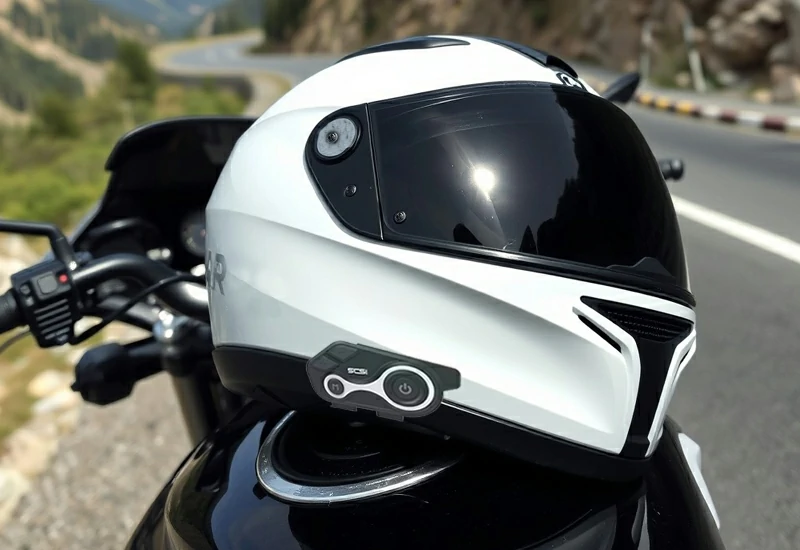
4. On-site Construction Skills and Campsite Selection
Choose a leeward and water-proof area to build a campsite to avoid cold winds and mountain stream moisture at night. The campsite should be away from cliffs, rivers or hillsides to ensure safety. The tent entrance faces east to help the first ray of sunlight in the morning. Lay a moisture-proof mat on the ground and check for sharp stones or tree roots to avoid sleeping discomfort.
5. Food and Outdoor Cooking
It is recommended to bring canned food, instant food, compressed dry food, high-calorie chocolate, nuts, etc., and use portable stoves and cookers for simple cooking, such as noodles, hot soup, and coffee. For camp barbecue, marinade and aluminum foil should be prepared in advance, and environmental awareness should be kept in mind – take away the garbage to avoid polluting the natural environment.
6. Dealing with Weather Changes
The climate in plateaus and mountainous areas is changeable. It is often sunny during the day, but suddenly turns to wind and rain in the evening, and even snow and hail may occur. Therefore, responding to weather changes reasonably is the key to ensuring the safety and comfort of camping trips. First of all, during the riding process, you must prepare high-performance windproof and rainproof riding jackets, multi-layer riding pants with linings, waterproof gloves and waterproof shoe covers to effectively block the invasion of rain and cold wind, and avoid the loss of body temperature leading to hypothermia or colds.
For helmets, it is also important to equip them with waterproof covers or sealed protective layers to prevent rain from seeping into internal electronic devices, such as Bluetooth intercoms and cameras, affecting their use. It is recommended that motorcycle luggage and fuel tank bags use IPX6 waterproof designs, and use waterproof covers or special covers to prevent equipment, clothing, and electronic products from getting wet.
The temperature drops sharply at night, especially in plateaus or forest areas, and the temperature difference between day and night can reach more than 10°C. At this time, you need to prepare down sleeping bags, fleece blankets, and thermal pads in advance, and use inflatable pads to prevent ground cold air from penetrating. Using moisture-proof pads and thermal insulation films in tents can effectively improve sleeping comfort. If bad weather is foreseen, you should also bring a simple emergency shelter or a life-saving blanket to ensure quick protection in the event of sudden heavy rain or strong winds. Only with adequate climate response measures can the entire motorcycle camping process be safe and worry-free.
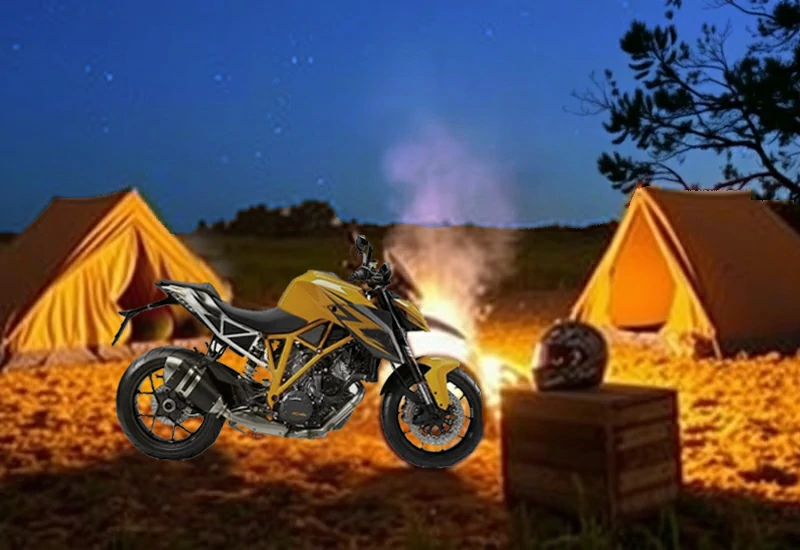
7. Nighttime Entertainment and Safety Reminders
Beside the campfire is an indispensable time for relaxation when camping. The SCS S7X Bluetooth helmet intercom can also be used as a small speaker when camping, playing soothing music to create a quiet night atmosphere. At this time, you need to pay attention to fire source management and stay away from tents, motorcycles and flammable materials. Do not leave the camp at will at night, carry lighting tools and rescue whistles to prevent getting lost or wild animals approaching.


